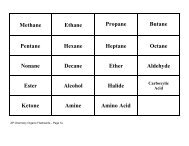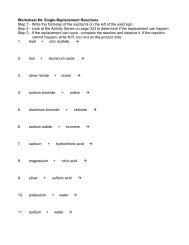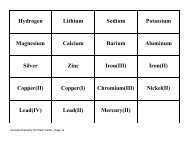Common Ions and Their Charges - ScienceGeek.net
Common Ions and Their Charges - ScienceGeek.net
Common Ions and Their Charges - ScienceGeek.net
You also want an ePaper? Increase the reach of your titles
YUMPU automatically turns print PDFs into web optimized ePapers that Google loves.
Tips for Learning the <strong>Ions</strong><br />
“From the Table”<br />
These are ions can be organized into two groups.<br />
1. <strong>Their</strong> place on the table suggests the charge on the ion, since the neutral atom gains or loses a<br />
predictable number of electrons in order to obtain a noble gas configuration. This was a focus in first<br />
year chemistry, so if you are unsure what this means, get help BEFORE the start of the year.<br />
a. All Group 1 Elements (alkali metals) lose one electron to form an ion with a 1+ charge<br />
b. All Group 2 Elements (alkaline earth metals) lose two electrons to form an ion with a 2+<br />
charge<br />
c. Group 13 metals like aluminum lose three electrons to form an ion with a 3+ charge<br />
d. All Group 17 Elements (halogens) gain one electron to form an ion with a 1- charge<br />
e. All Group 16 nonmetals gain two electrons to form an ion with a 2- charge<br />
f. All Group 15 nonmetals gain three electrons to form an ion with a 3- charge<br />
Notice that cations keep their name (sodium ion, calcium ion) while anions get an “-ide” ending<br />
(chloride ion, oxide ion).<br />
2. Metals that can form more than one ion will have their positive charge denoted by a roman numeral<br />
in parenthesis immediately next to the name of the<br />
Polyatomic Anions<br />
Most of the work on memorization occurs with these ions, but there are a number of patterns that can<br />
greatly reduce the amount of memorizing that one must do.<br />
1. “ate” anions have one more oxygen then the “ite” ion, but the same charge. If you memorize the<br />
“ate” ions, then you should be able to derive the formula for the “ite” ion <strong>and</strong> vice-versa.<br />
a. sulfate is SO4 2- , so sulfite has the same charge but one less oxygen (SO3 2- )<br />
b. nitrate is NO3 - , so nitrite has the same charge but one less oxygen (NO2 - )<br />
2. If you know that a sufate ion is SO4 2- then to get the formula for hydrogen sulfate ion, you add a<br />
hydrogen ion to the front of the formula. Since a hydrogen ion has a 1+ charge, the <strong>net</strong> charge on<br />
the new ion is less negative by one.<br />
a. Example:<br />
PO4 3- HPO4 2- H2PO4 -<br />
phosphate hydrogen phosphate dihydrogen phosphate<br />
3. Learn the hypochlorite chlorite chlorate perchlorate series, <strong>and</strong> you also know the series<br />
containing iodite/iodate as well as bromite/bromate.<br />
a. The relationship between the “ite” <strong>and</strong> “ate” ion is predictable, as always. Learn one <strong>and</strong> you<br />
know the other.<br />
b. The prefix “hypo” means “under” or “too little” (think “hypodermic”, “hypothermic” or<br />
“hypoglycemia”)<br />
i. Hypochlorite is “under” chlorite, meaning it has one less oxygen<br />
c. The prefix “hyper” means “above” or “too much” (think “hyperki<strong>net</strong>ic”)<br />
i. the prefix “per” is derived from “hyper” so perchlorate (hyperchlorate) has one more<br />
oxygen than chlorate.<br />
d. Notice how this sequence increases in oxygen while retaining the same charge:<br />
ClO - ClO2 - ClO3 - ClO4 -<br />
hypochlorite chlorite chlorate perchlorate





